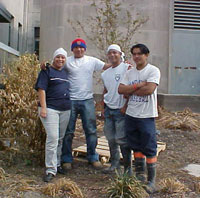Workers face many hazards in New Orleans
By
Dana Gilmartin
New Orleans
Published Nov 13, 2005 10:02 PM
A labor shortage is
evident all around New Orleans. Burger King is offering a $6,000 signing bonus;
Popeye’s is offering $9 an hour. Restaurants have to close early due to
lack of staff. Some use paper cups and plastic plates because they can’t
find anyone to operate the dishwasher. In hotels, rooms are cleaned every other
day instead of daily (horrors!).
|
These Honduran workers
removed asbestos from severely
contaminated hospital.
|
Not aware of their racism and classism,
some people say, “Why don’t New Orleanians come back and fill these
jobs? Why aren’t they helping with the clean-up and rebuilding?” Why
not indeed? Let’s look at some of the reasons.
Major sections of
working class and poor communities were badly damaged by Hurricane Katrina and
parts are utterly destroyed. Power has not yet been restored to the ninth Ward.
Driving through the ward at night shows how few people are there. One or two
houses per block have a light on, probably battery-operated.
Schools are
still closed, so why would families with children return? The floodwaters
damaged the ground floors of buildings, which in many cases held corner grocery
stores, restaurants and pharmacies. You can drive for miles without finding
access to basic supplies.
Public transportation has barely started up
again. Even thrift stores had their furniture inventories destroyed, so how are
families supposed to inexpensively refurnish their homes? Block after block, the
curbs are piled high with dry wall and other materials from houses that have
been gutted, a visual reminder of how widespread the damage was.
Speak to
people who have gone back to their homes to find what is salvageable. One woman
grimly holds up two Christ mas ornaments, the sum total of her undamaged
possessions.
Some folks whose apartments were above the first floor and
did not sustain major losses are able to work now. If they work for a company
that has a contract with FEMA, they can eat breakfast and dinner free of charge
at the FEMA support tent, can pick up bag lunches and bottled water (finally the
pallets of water appear!) and drop off laundry, all free of charge.
Some
workers whose homes and cars were destroyed are being put up in hotels by their
employers. On the other hand, some workers report being housed in apartments
where the plumbing doesn’t work and the rats are as big as cats. Others
are staying in motels where major structural damage has not yet been repaired.
In many cases, the families of these workers are still in Atlanta, Baton Rouge
or Houston.
Cleanup is the major activity underway in downtown New Orleans
and in the hard-hit areas. The basements of hotels, office buildings and
hospitals flooded to levels that damaged pipe insulation and boiler insulation
containing asbestos. This means that the wreckage—rotten food, drop
ceilings, drywall and all the contents of the basements—is conta m inated
with asbestos, not to mention the lead in old paint.
Who is doing this
cleanup? African-American and non-English-speaking workers: Brazilians,
Hondurans and others. Many are not even familiar with the words for asbestos and
lead in their primary language, which shows that the contractors didn’t
train them on the health effects of these substances, as is required under
“right to know” laws.
Electrical power may still be
energized, even though the floors are wet.
These workers are not in unions
and are vulnerable to unsafe and unhealthy conditions. In the hurry to make a
buck, the contractors are bypassing recognized safe practices for minimizing
worker exposure to hazardous substances and reducing the spread of
contamination.
In residential areas, many roof repair jobs are underway.
The workers are not tied off for safety; other precautions to prevent falls are
not being taken. Ironically, one site where roofers were seen without fall
protection was the roof of a union hall.
Other workers in “cherry
pickers” can be seen perilously close to live power lines. Their training
in terms of safety has been scant and they often have not been given the
protective gear they need. Many of these workers are Latin@.
Meanwhile, at
the landfills and the debris collection areas, the workers are exposed to high
levels of dust. Tens of millions of pounds of putrefying chickens and shrimp add
intense and nauseating odors.
Faced with the super-exploitation of workers
under these conditions, an opportunity is presented for unions, community groups
and worker safety and health alliances to network and increase awareness,
disseminate educational material and make site visits. The combined power of
union membership and community pressure can stop the killing, maiming and
sickening of our multi-national workforce.
Articles copyright 1995-2012 Workers World.
Verbatim copying and distribution of this entire article is permitted in any medium without royalty provided this notice is preserved.
Workers World, 55 W. 17 St., NY, NY 10011
Email:
[email protected]
Subscribe
[email protected]
Support independent news
DONATE


